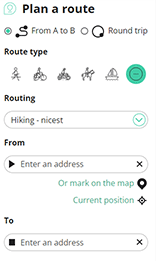

Enclosed castle, in its current form largely dating back to the first half of the 18th century, with surrounding park, located between the Mandel - which fed the ramparts - and the church, on which the castle was traditionally oriented (see engraving in A. Sanderus, 1641 and Landboek 1736). Access to the park to the west via the castle gate with concierge on the Stationsstraat, in 1969 simplified rebuilt in the back as a simple brick volume under a slate mansard roof. Entrance gates …Read more
 Azure
Azure![]() | | Public | Dutch
| | Public | Dutch

Select one of the most popular activities below or refine your search.
Discover the most beautiful and popular trails in the area, carefully bundled into appropriate selections.
Select one of the most popular categories below or be inspired by our selections.
Discover the most beautiful and popular attractions in the area, carefully bundled in appropriate selections.
With RouteYou, it's easy to create your own customised maps. Simply plot your route, add waypoints or nodes, add places of interest and places to eat and drink, and then easily share it with your family and friends.
Route planner

© 2006-2025 RouteYou - www.routeyou.com
Recent commentsShow all
No comments found.